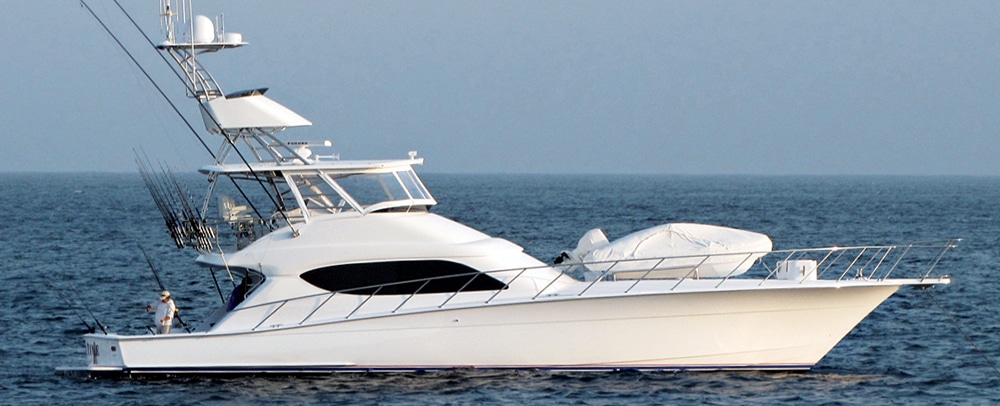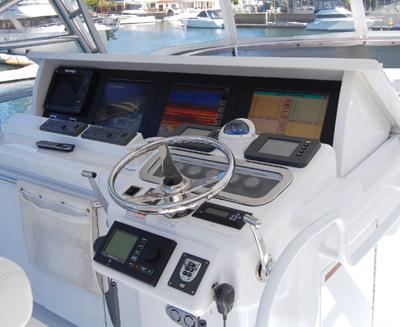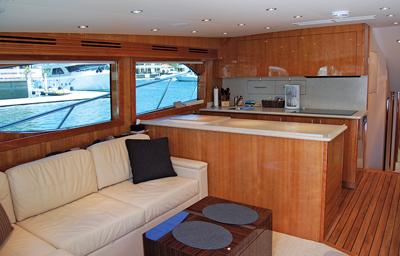
Hatteras 60GT
Of course, there’s absolutely nothing wrong with a production Hatteras 60GT. The tournament- ready battlewagon has been well received by serious fishing and boating enthusiasts alike around the world..
With a sharp entry, the 60GT with 1,800-horsepower Caterpillar C32s can reach a top speed of 42 knots at 2300 rpm. At 1700 rpm, expect an effortless speed of 30.6 knots while consuming a total of 100 gallons per hour. While testing the standard GT, I found a tough head-sea boat that handled the five- to six-foot seas cruising at an impressive 26 knots. At the time, the 60GT was the first Hatteras built completely with a resin-infused hull. Hatteras uses a solid bottom, and awthartship stringers with PVC core encapsulated in fiberglass. The topsides and superstructure also use PVC core.
In fact, straight from the factory, this Hatteras represents a fine, tough, strong performing vessel. But taking to heart the old adage “There’s never been a perfect boat” — meaning perfect for everyone — West Coast based owner Preston King decided that, with a little customization, his boat Reel Time could be perfect.
For starters, West Coast anglers fish differently than their Atlantic brethren fish. Working with Stan Miller Yachts of California, King specified a variety of options to suit his specific needs. There is a huge West Coast-style baitwell in the center of the cockpit that also supports the fighting chair or a removable rocket launcher. You’ll find two more livewells on the bow. (Pacific anglers take their livies very seriously.) Reel Time is equipped with a two-speed air-conditioning pump that supplies water to the baitwells. The pump is so powerful that the manufacturer measures it not in gallons per hour, but rather in horsepower — 1½ horses to be exact. Baitwell pump redundancy includes DC pumps plus a third, separate pump for the wells on the bow.
Other changes and additions to what was already a super cockpit designed for serious anglers include an advanced cockpit station; a larger tackle station, which Hatteras installed to King’s design; and custom, thigh-high rails because walking to the bow is a much more frequent pastime for West Coast fishermen. The standard cockpit mezzanine is a great perch from which to watch your baits on any coast.
I love the access to the tower from the flying bridge. But, let me back up. Perhaps the most unique custom feature on Reel Time is the fold-down buggy top on the tower. There is a relatively low, fixed bridge between the Pacific Ocean and the owner’s home. He couldn’t have a fixed tower and still take his boat (docked behind his home) out to sea. So at the touch of a button, all the satellite domes and their attendant systems lock down. Then, the antennas and the buggy top fold over toward the cockpit and below the level of the flying bridge hardtop. When back in the “up” position, the tower “bucket” is easier and more secure to access than a standard tower.

The unstayed, full-length outriggers lower manually by hand. These carbon-fiber miracles ended up so light that you can even raise and lower them with one hand while holding on with the other. The custom stainless steel rails and welding used throughout the boat were spectacularly executed.
King’s details continued with the electric and electronic systems. They run through a custom-written computer program that manages it all. And complete control and monitoring of everything electrical and electronic can be displayed on any TV aboard. But that’s not all. It can also all be sent to the owner’s home and displayed on any TV there, allowing King to keep an eye on his boat at all times.
Another custom feature ties the autopilot into the bow thruster so that if you want to point in a certain direction during a drift, you can set the autopilot and it will hold you on that heading. You can also plug a desired sea-surface temperature into your sounder, then use it as a temperature waypoint. Underwater cameras augment the ones on each outrigger, the back of the flying bridge, belowdecks and in the engine room.
Because this boat anchors frequently, there is a specially designed inverter system with a heavy-duty bank of Northstar batteries. As soon as you shut down the generator, all systems automatically shift over to battery power through the inverter and you can actually run everything except your freezers overnight without running a generator. A welcome change for both the owner and your neighbors.

Hatteras offers several different interior options and finishes, demonstrating its willingness to straddle production and customization markets. Choices range from three to four staterooms to an enclosed flying bridge. It’s tough to improve on the standard upperdeck layout that features a U-shape galley to port, a dinette and a settee abaft the galley.
I have never been aboard a Hatteras with anywhere near as much customization as this boat. From the transom livewell to the hydraulically operated tuna tower, this boat has been changed and upgraded dramatically, making an already great ride a really great ride. This project should alert anyone considering the pros and cons of custom versus production that it may just be possible to have a little bit of both.
Specifications
LOA: 62’2″
Beam: 19’0″
Draft: 4’9″
Displ.: 90,000 lb.
Fuel: 1,800 gal.
Water: 200 gal.
Power: 2 x 1,800-hp Caterpillar C32 ACERT diesels
Base Price: $2,500,000
Hatteras Yachts, 252-634-4895; hatterasyachts.com









